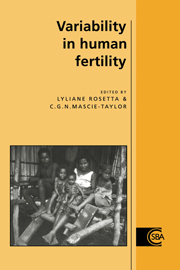Book contents
- Frontmatter
- Contents
- List of contributors
- 1 Introduction: the biological anthropological approach
- PART I HORMONAL ASPECTS OF FERTILITY REGULATION
- 2 The hypothalamo-pituitary regulation of the reproductive function: towards an increasing complexity
- 3 Lactation, condition and sociality: constraints on fertility of non-human mammals
- 4 Evidence for interpopulation variation in normal ovarian function and consequences for hormonal contraception
- PART II INTERPOPULATION VARIABILITY
- PART III METABOLIC AND ENERGETIC ASPECTS OF REGULATION
- Index
4 - Evidence for interpopulation variation in normal ovarian function and consequences for hormonal contraception
Published online by Cambridge University Press: 03 February 2010
- Frontmatter
- Contents
- List of contributors
- 1 Introduction: the biological anthropological approach
- PART I HORMONAL ASPECTS OF FERTILITY REGULATION
- 2 The hypothalamo-pituitary regulation of the reproductive function: towards an increasing complexity
- 3 Lactation, condition and sociality: constraints on fertility of non-human mammals
- 4 Evidence for interpopulation variation in normal ovarian function and consequences for hormonal contraception
- PART II INTERPOPULATION VARIABILITY
- PART III METABOLIC AND ENERGETIC ASPECTS OF REGULATION
- Index
Summary
Introduction
There is significant variation in the endogenous steroid hormone profiles of non-contracepting, menstruating women in different populations. Women in non-industrial societies frequently exhibit lower levels of progesterone and estrogen compared to Western subjects. This may be mediated primarily by inter-group differences in dietary composition, although we cannot rule out the possible effects of other factors such as women's current nutritional status, developmental environment, genetics, and activity patterns. There is also significant inter-population variation in the absorption, distribution, clearance and excretion rates of exogenous, synthetic contraceptive steroids. Researchers interested in such pharmacokinetic parameters have been unable to account consistently for these differences. In this chapter it is suggested that interpopulation variability in the pharmacokinetics of contraceptive steroids can be explained by similar variability in the metabolism and secretion rates of endogenous steroids.
There are a number of policy implications that arise from the hypothesis that endogenous steroid production and metabolism affect responses to exogenous or synthetic steroids. For example, inter-population differences in pharmacokinetic responses to hormonal contraceptives cause variable side effects such as intermenstrual bleeding which can severely impact contraceptive continuance rates. Understanding the causes of interpopulation responses to exogenous hormones may therefore enable more suitable doses for specific populations to be recommended than those currently used and, hence, improve policy effectiveness. In addition, the doses thought to be required for contraceptive efficacy in different areas of the world are often based on studies of Western women who may be poor models for other populations.
- Type
- Chapter
- Information
- Variability in Human Fertility , pp. 46 - 66Publisher: Cambridge University PressPrint publication year: 1996
- 2
- Cited by

